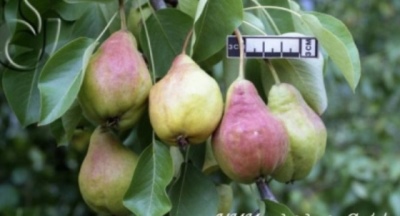
- Authors: I. A. Puchkin, I. P. Kalinina, E. P. Karataeva, M. I. Borisenko (Scientific Research Institute of Horticulture of Siberia named after M. A. Lisavenko)
- Appeared when crossing: Theme x Favorite Klapp
- Fruit weight, g: 88
- Ripening terms: early autumn
- Fruit picking time: in mid-September
- Appointment: fresh, for juices and drinks
- Growth type: medium height
- Yield: moderate
- Marketability: high
- Crown: round, thickened
It is not easy to choose fruitful and non-capricious fruit trees for planting in the country, especially in Siberia and the Urals, where the climate is harsh and unstable. One of the pear varieties with good survival rate and quick adaptation to difficult climatic conditions is Kupava.
Breeding history
Pear Kupava was bred by a group of breeders from the M. Lisavenko Research Institute of Horticulture in Siberia (Barnaul) 50 years ago. The variety was obtained by crossing two types: Favorite Klapp and Tema. The selection was carried out by experts M. Borisenko, I. Kalinina, E. Karataeva, and I. Puchkin. The variety was added to the State Register of the Russian Federation in 1972. Kupava is the most productive, growing in the Urals and Siberia.
Description of the variety
The early autumn Kupava species is a medium-sized fruit tree, which usually reaches a height of 4-5 m. It is characterized by a rounded crown shape, strong thickening of green leaves, upright thin shoots of a yellowish-brown color, elongated petioles and fluffy flowers. Apples are formed on simple and complex ringlets.
Fruit characteristics
Pear Kupava belongs to the group of medium-fruited. Under favorable conditions, fruits gain weight up to 88 grams, and are up to 13-15 cm long. Sometimes fruits grow up to 100-120 grams. The shape of the fruit is usual - pear-shaped with a pronounced tuberosity of the surface and a sharp escape to the top. Often, one side of pears is beveled.
A ripe pear has a golden yellow color, diluted with a red blush, which occupies a third of the fruit's surface. The apple peel is thin, elastic, glossy and slightly oily. If you look closely, you can see small greenish specks on the surface of the pear. The asymmetrical fruit rests on an elongated oblique stalk.
The advantages of the variety are transportability of fruits and good keeping quality with absolute preservation of taste and marketability. Apples have a universal purpose: they are consumed fresh, widely used in cooking, and also processed.
Taste qualities
The pears taste excellent. The snow-white apple pulp is dense, fleshy, prickly and mid-term. The pear has a balanced taste, sweet and sour, complemented by a pronounced fruity aroma.
Ripening and fruiting
Kupava belongs to the early autumn species. The tree begins to bear crops 4-5 years after planting. Pears ripen by the middle of the first month of autumn. The duration of the consumer period is extended. It falls on the period from September to October.

Yield
The yield indicators for the variety are average. Observing basic agricultural techniques, 20.2 kg of apples can be harvested from one tree per season. On an industrial scale, the indicators are as follows: more than 11 tons per hectare.
Self-fertility and the need for pollinators
Kupava is a self-fertile species, so it is not necessary to plant donor trees nearby on the site. Self-fertility is both an advantage and a disadvantage, since over time the viability of the tree decreases, and with it fertility.Planting a number of pollinating trees flowering at the same time as Kupava will help to solve this problem. The best additional pollinators are the following varieties: Skazochnaya, Perun, Larinskaya, Samara beauty.
Landing
This pear variety can be planted in spring (March-early April) or autumn (3 weeks before frost). When planting trees, do not forget about the distance so that the trees do not interfere with each other.


Growing and care
The optimal place for growing the Kupava fruit tree is a well-lit area with loamy or chernozem soil and no surface groundwater.
Caring for a fruit tree includes watering, feeding, protecting against insects and viruses, as well as loosening the soil in the near-stem zone. In addition, it is necessary to form a crown, monitor the density of foliage, periodically thinning it, and carry out sanitary pruning of branches. Trees are prepared for winter by mulching and winding the trunk.



Disease and pest resistance
The variety has good resistance to many fungal diseases (scab, powdery mildew). Sometimes the tree is exposed to root rot and bacteriosis. The most dangerous pest is the moth, which can be eliminated by spraying with copper sulfate.

Like any other fruit trees, the pear needs protection from various diseases and pests. When planting a pear on your site, you need to know in advance what diseases you should beware of. To successfully carry out the struggle, it is first necessary to correctly identify the cause of the problem. It is important to distinguish signs of disease from manifestations of the presence of insects, ticks, caterpillars and other types of pests.
Resistance to soil and climatic conditions
The high stress resistance of the tree allows it to grow and bear fruit in different climatic conditions. The tree easily tolerates mild frosts, short droughts and heat.





































































